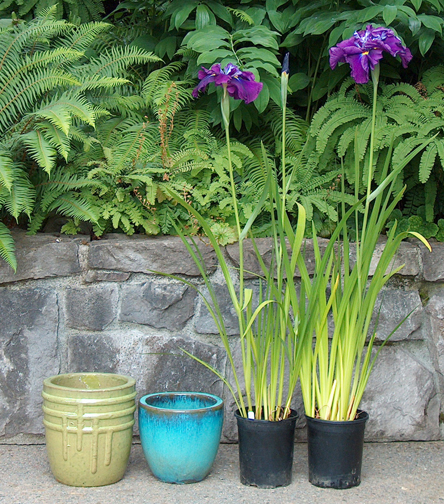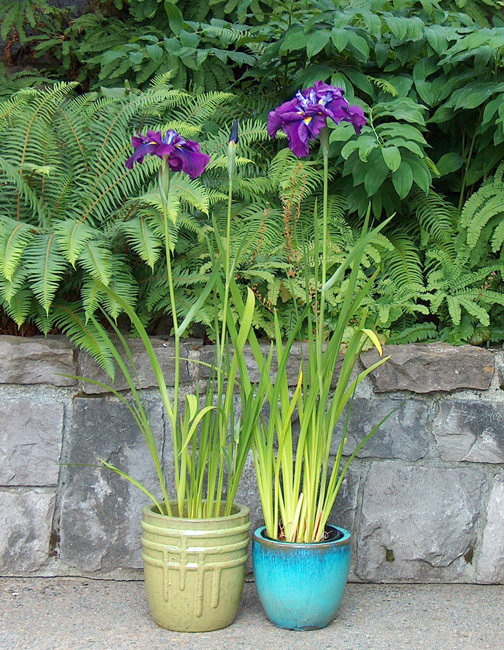I. ensata(Japanese), I. laevigata, Spec X
Iris ensata and Iris laevigata have been cultivated with container culture for centuries. Many find growing in containers easier than in the garden, because you may have better control of watering, and soil blending.

Pot: Six to ten inch one gallon plastic container is the minimum with yearly division, for a single or double fan plant. A larger two gallon container can maintain a plant for two years. We highly recommend a three to five gallon container to maintain these large plants.
Soil: Use a good potting mix. We use Miracle-Grow Potting Mix six month’s continuous plant food. Plant so that the rhizome is covered by one half to one inch of potting soil.
Sun: Full sun with a minimum of six hours to bloom properly. Afternoon shade in hot areas will benefit the plant and bloom. The container needs to be shaded to help keep the root zone cool. This can be achieved by shading the container with a shingle, or by double potting, by placing the plastic container into a larger heavier ceramic container. The later being the method we use, and very decorative for the patio and garden. Note: A larger decorative container can hold several smaller poly containers within it.

Water: The plant should not dry out. Keep evenly moist by daily watering. A deep tray filled with water will allow the plant to stay completely hydrated for longer periods of time. For larger collections a shallow child’s pool, with holes drilled into the sides, one to two inches from the bottom can be used. In the garden, ground treated two by fours laid on their sides can make a frame to hold a lining of polyethylene sheeting for shallow flooded beds. The rhizome crown needs to be above the water line or the plant may drown, this critical for Iris ensata (Japanese). SPEC-X each one is a not known factor, to be safe plant so that the rhizome is above the water line. Iris laevigata can grow with its rhizome under the water line, two to four maximum inches. However I recommend that the new plants are started with the rhizome above the waterline. Later lowering to be submerged after the new top growth shows that the plant has anchored with new roots.
Fertilizer: Use a slow release for acid loving plants mixed into the potting mix. Or use a water-soluble of acid type and add directly to the water. Do not use bone meal, this will kill acid loving iris.
Transplanting: Repot right after bloom. Lift the plant, discarding old soil, roots and rhizome. Using new potting soil, place one or two new fans (growths) that have been trimmed to six or eight inches back into the container. New growth will start immediately.
Winter Dormancy:After a light freeze, cut all foliage off at container level. In mild winter areas (USDA Zone 8-9 for Spec-X and Iris laevigata), containers can remain in the pools all winter (Japanese iris, zone 9). In colder climates, lift the containers from the flooding pools and bury to the rim in a prepared bed with a good mulch cover. In the spring, return the containers to the flooding pool, fertilizing after new growth starts to appear. After bloom, lift the plants, divide and start over.